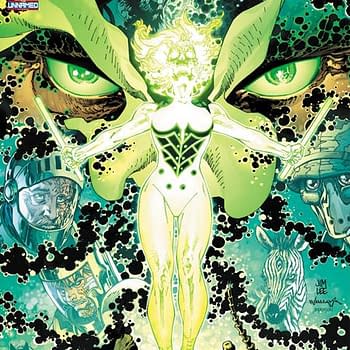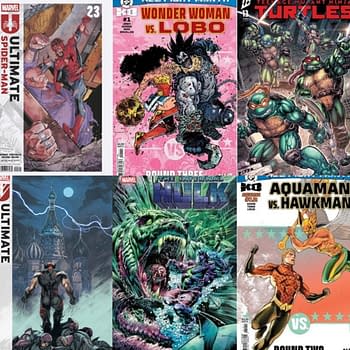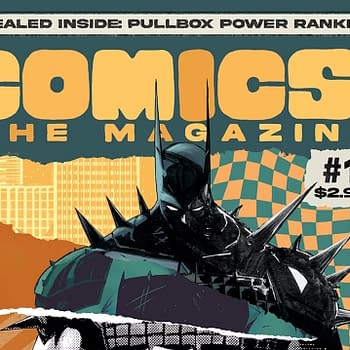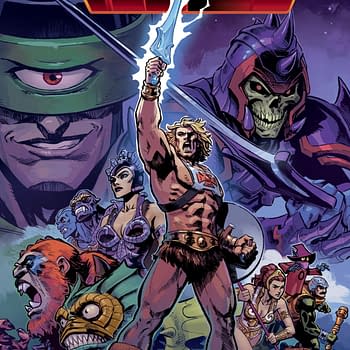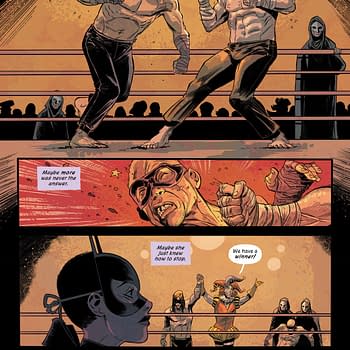Posted in: Comics, Recent Updates | Tagged: comic con, Comics, jai nitz, kate beaton, len wein, Loyd Kaufman, paul feig, seth green, shannon wheeler
Seth Green, Jai Nitz, Kate Beaton, Len Wein, Paul Feig, Lloyd Kaufman And Shannon Wheeler Remember When Comic Cons Were About Comics
Mathew Klickstein writes,
"As I like to say, we won – the geeks have inherited the earth!" Len Wein, editor of Alan Moore's Watchmen and creator of such comic book mainstays as Wolverine, Lucius Fox, Storm and Swamp Thing, amongst a rogue's gallery of others, says.
Wein nevertheless tempers his triumphant pronouncement with the notion that though he's delighted to see "Comic-Con" as one of the answers (or, rather, questions) on mainstay broadcast television touchstone Jeopardy!, there remains some doubt in his heart about what it means that his "little niche" and he have found mainstream acceptance.
Initially, as Wein puts it, conventions for "those of us who loved that medium and what it could bring to us" made for a community that first-wave geeks couldn't find anywhere else.
That is until it was more recently co-opted by film studios that figured out, as Wein suggests, You know, maybe we can pitch our new movie to that audience. They certainly, at least as a majority, will want to see it and word will get around. Let's see what we can do!
Wein believes the fact this ploy actually worked is what made for the "not-quite-so-Comic-Con." This same transmogrification is what has happened to the "entire medium of fandom," in his point of view.
Back when fanboy "nerd" or even "geek" was still a "pejorative term," as ultra-low-budget film studio Troma president Lloyd Kaufman recalls, there was no one "proudly proclaiming his inner nerd."
In the early Eighties, before shepherding the likes of future filmmaking stars Eli Roth of Hostel fame, Guardians of Galaxy writer-director James Gunn and South Park's Trey Parker and Matt Stone, Kaufman found some modicum of underground credibility through such small-time cult classics as 1984's The Toxic Avenger, fittingly involving the transformation of a loser janitor named Melvin who immerges from a trashcan of disgusting industrial waste as a misfit superhero fighting for the "little guy."
Kaufman has long worked out of the same cramped office space on a garbage-lined street deep in the outskirts of New York City with almost no budget for his courageously campy projects made for a distinctly underground scene still gleefully craving schlock. But one thing has changed, in Kaufman's creatively sick-and-twisted mind: alleged "nerd pride" now means that "there are no nerds anymore; everybody's a nerd."
It's a logic akin to Pixar's The Incredibles: "If everyone's special, no one is."
Paul Feig, co-creator of Freaks and Geeks and director of Bridesmaids and the upcoming Ghostbusters reboot, is a lifetime comic convention fanatic who recalls the "sea change" that he agrees occurred especially at the most renowned convention in the country, perhaps world: That which takes place in San Diego, California.
Two or three decades ago, the San Diego Comic-Con celebrated mere comic books and a few scant films that were "the lowest rent, indie or exploitation kind of movies; it was almost a joke."
Feig and his pals would go for the "action figures and comic books and all the cool gear," and would stand around laughing at "all those terrible movies they're trying to push on us."
Within the last five or six years, "suddenly all of the movie studios discovered Comic-Con and this untapped audience. Now you go to Comic-Con and all of the comic books are literally pushed to the edge ring; it's just sort of circling the outer edge of everything. It used to be cool to go meet your favorite comic book artists and walk from table to table to see their stuff and talk to them. Now they're all shoved to the back where you have to trek over to find them. It's almost like the ghetto back there. Everything else has been taken over by these enormous displays."
Though Feig suggests there's nothing here necessarily good nor bad, there's a certain element of Geek Culture exploitation at play.
"Look," Feig continues, "I've been involved with enough panels to know that whatever show or movie comes in, I know there's going to be a big number of people involved behind-the-scenes – whether they are actors or studio people or the creative people themselves – who roll their eyes at the idea of 'Here we go: let's go look at the weirdoes.'"
This is emblematic of a lack of control or ownership of Geek Culture by geeks themselves, which rankles Feig who is ardent about such events and communities as Comic-Con needing to exist as a "safe harbor for people who are purely into this stuff."
Sure, as a financially viable member of the Hollywood community himself, he doesn't necessarily fault the business component of the exchange. But Feig nevertheless has observed that "the cool kids have taken over the nerd table and kicked all of the nerds out."
Beyond the possible evaporation of the blood, sweat and tears of the nerds, Kaufman's concern rests in the fact that when a studio like Troma gets steamrolled by a mainstream giant that has co-opted one of the few venues where he was able to find some promotional opportunities before being shoved into the hinterlands of the building, the machinations of these big studios become what is seen by a vast audience as largely representing Geek Culture itself.
Comic-Con can therefore possibly be seen as a vehicle for misrepresentation or what is known in socio-political circles as "false consciousness."
In Kaufman's words, "The underground does the visionary work, then the mainstream takes it over."
On the other side of the coin, we have Wein confessing, "I don't have the same comic convention that anyone else has. I'm a fan at heart, I still love the things I love and I still geek out; I mean, I have a book coming out today and I can't wait to get to the comic shop to get my copy! To see how it came out! But I've been doing this fifty years. God help me, TV Guide referred to me as a god once. So, I guess I've reached godhood in this industry and I don't see the convention in the way a lot of the other people do."
While Wein embraces how monumentally huge the Comic-Con scene has become, swelling with pop culture and mainstream fare pushing aside the littler guys like Kaufman, his experience is obviously "not like the true fan, whose waited on line for three nights in the rain on the lawn to get into that room for that panel on that day. Their convention experience is radically different than mine."
For the smaller, independent newbies on the scene, the prospect of the gargantuan Comic-Con can be "very overwhelming at first," as indie comic creator Kate Beaton tells me.
Beaton's Hark! A Vagrant started as a webcomic focusing on the quirky creator's own decidedly nerdy passion for historical events and the inherent comedy of errors she sees within that realm.
Clearly, Beaton wasn't alone here, as her strip went viral, earned the Canadian artist a treasure trove of prestigious awards and led to her work's inclusion in the likes of McSweeney's, The New Yorker and, of course, book collections of her own.
"I never had that time to warm up to conventions," Beaton says, adding that by the time she arrived at her first con, her comic was popular and thus she was already something of a celebrity in the scene. She was more or less suddenly thrust into the fray without that early preparation many indie artists develop who are still building their brand and aren't subject to a horde of autograph hounds already familiar with their work.
"Most of us are the bookish type," Beaton adds. "A little introverted, used to working alone, used to personal space. Then you're in this convention hall, and there are people everywhere, and there's jostling and everyone's excited but also nervous and tired and things can be hectic. I didn't think they'd be as exhausting as they are, so it took some getting used to."
Although Beaton says that the people she's met at cons are all "so polite and worried that they are awkward" despite being "totally normal and lovely," she does pine for the ability to "talk to all these nice people in a café or something."
Beaton feels she's missing out a bit – along with some of the other allegedly awkward and introverted fellow nerds – on the niche intimacy the conventions use to afford before being overtaken by the mainstream.
"But instead, we are all there in the Jostle Dome and someone's elbow is in your face and you're sweating and someone farted nearby and, well, we'll just make the best of it," Beaton writes in her email. "I enjoy them, but they still overwhelm. Just because of the numbers and high energy."
And if the conventions have indeed become such a place for the indie creators behind-the-scenes, one can only imagine – or have far too many past experiences with – the gruesome realities of what it can be like for a nerdy patron these days.
Longtime comic book writer Jai Nitz confirms that "comic book conventions aren't about comic books anymore. They're celebrity pop culture festivals."
Nitz is one of only 150 professional comic book writers in the entire world, believe it or not, justifying his claim via a monthly list of authors published by the primary comic book distributor, Diamond Comics.
"You're more likely to meet a starter in the NBA than to meet a comic book writer, statistically," Nitz says.
In addition to his work on countless mainstream series such as Batman, Nitz wrote the very first book for DC Comics that was entirely in Spanish as part of the Blue Beetle series. He's also the creator of Latino comic book character El Diablo, who was recently inducted into the new Suicide Squad film team that will be blasting the box office this summer.
Nitz, a scholar of the field and lecturer on the subject at the University of Kansas, knows his comics. When I ask him how and why comic conventions changed from a nerdy reprieve in the late Seventies for a handful of weirdoes who just wanted to gather together and meet heroes like Jack Kirby and Stan Lee, he laid it all out on the line.
Namely, wrestlers are to blame. And Chicago.
"What happened was that Wizard World, which used to be the big comic book magazine Wizard Magazine, bought the big convention which had been the Chicago Comic Con in the Eighties and Nineties. They turned it into a place to keep the comic book base going, but also brought in a lot of wrestlers, who brought in a lot of money."
Once Wizard World discovered that the wrestlers brought in a fair amount of fanboys who would wait in line for paid autographs and photos, they thought of other fandom markets that could be tapped. Star Wars, for example. Bring in Billy Dee Williams! Or what about Star Trek? Just grab Patrick Stewart!
"Huge lines for these people," Nitz says, adding that the lines grew and grew for more "niche things for celebrity nerds" such as those from the cult sci-fi series Firefly.
It may have only been on for twelve episodes, but conventions around the country – which began taking notice of what was going on up there in Chicago – knew there was a dedicated fan base willing to travel anywhere to see the cast and crew from their favorite series nevertheless.
And they were right.
"Whether you're talking about comic books or wrestling, you're not just discussing the nerd life, but the fantasy," David Saperstein, a former associate producer for WWE (World Wrestling Entertainment), explains. "Both of those worlds are fantasy."
Saperstein, equally a fanboy of comic books, action figures, sports and wrestling itself, believes there is something to consider in the working class mentality of those laboring away at their nine-to-five jobs and needing to find a sanctuary in fantasy escapism.
Be it those peopled by superheroes or warrior wrestlers, both arenas offer "a chance to suspend disbelief and go to a different world." One that is no longer governed by the kind of dolorous or drab strictures of the tedious everyday domestic slog.
In referring to wanting a "glorious" superpower as a kid, Saperstein suggests that there's really no difference here from wrestling, as both aspirations allow people to get away from real life and their daily problems.
This is particularly true now that professional wrestling and comic books are "everywhere for everybody," and are not merely relegated to the more inaccessible underground from which they initially spawned.
Having found some success of his own, Nitz doesn't necessarily see an issue with the way the conventions have changed over the past five years.
Yes, there may be a problem with the fact that comic books represent a reading experience and are being ousted by the visual experience of television shows and movies celebrated at the conventions. But that had a lot to do with the way that "spectacle" comic book movies have changed due in no small part to the superior CGI technology that has allowed for a more realistic and immersive experience for viewers, even beyond comic book fans.
And the films, once nearly the exclusive fare of nichey nerds, have definitely made their mark across the globe.
"In my classes, I deal with kids who are 18 to 22, and every year of their lives that they can remember, there has been, in the megaplex, a superhero action movie. Every summer. Since 2000 when X-Men came out, there has been a blockbuster film every year."
Nitz points out that there have been superhero movies that go back at least as far as 1978 with the original Superman. But between that time and the Tim Burton Batman film of 1989 starring Michael Keaton, and even a few years thereafter, the release of these kinds of films was more "sporadic."
Batman did well enough to prove there was a market there and that superhero movies could have a chance, and following the success of Bryan Singer's X-Men, came such blockbusters as Blade and Sam Raimi's Spider-Man. From there, it was Batman Begins in 2005, after which time, as Nitz puts it, the studios were hitting them out of the park.
These same mainstream studios knew they needed a place to promote and market their hugely expensive spectacle films featuring superheroes, rebooted and sequel-ed and prequel-ed to their hearts content.
Comic conventions would never be the same again.
"Look at the very beginnings of comic books," actor, voice actor and Robot Chicken co-creator Seth Green suggests in his wrapping up this major changeover in the industry.
"In the Twenties and Thirties and Fifties, they were designed as both satire and escapism. When Batman was on TV in the Sixties, American culture's understanding of those icons was that they were cartoony, and the definition of cartoony meant brightly-colored and a little bit silly. So you have a character who's as dark as Batman being portrayed culturally as something ridiculous; he's doing the 'Batusi,' and there's oversized BAMS, SPLATS, and POWS, because they think that they're transcribing a comic book into live-action. But what they're really doing is taking away all the pathos, all of the emotion, all of the depth of these characters, and just using the bright colors to make entertainment."
In Green's estimation, what changed from the Sixties to now, was something quite significant, something that anyone who intimately grew up with this iconography always saw. Even if this vision was not necessarily represented early on in a way that connected intimately with a larger, more mainstream audience.
"Over time, the cultural understanding of what these icons represented changed. There was a point, and it was in the Nineties, really, where it changed, from being, you know, Albert Pyun's [1990 cheesy adaptation of] Captain America to being the 'Winter Soldier.' It's no longer a dude in spandex, being silly."
"Culturally," he added, "we've accepted the value of these icons as being something more. It's the merging of the audiences. The very thing that comic books and genre enthusiasts complained about was that they were alone, that no one understood them, that all of the entertainment being made around these icons is stupid or disingenuous, like making fun of the audience for caring about it, and it's just not true anymore. I mean, The Avengers: it's the biggest f-cking movie of all time …"
Wrestlers as early interlopers into comic conventions or spectacle superhero films shoving aside the boxes of comic books and indie filmmakers like Troma's Lloyd Kaufman weren't the only components that led the way the scene has changed this past decade.
As longtime, Eisner Award-winning indie comics guru, regular New Yorker contributor and professor Shannon Wheeler of Too Much Coffee Man fame put it to me, it's really all about two words: "Neil" and "Gaiman."
Gaiman's groundbreaking Sandman series was "a real revolution," Wheeler says, adding that it was this series that brought in the "goth girls" and linked the scene to the world of hipsters, punkers and those Gaiman acolytes who Wheeler playfully refers to – at least in those earlier days – as "a group of people who only wear black."
Wheeler feels Gaiman helped in large part to make comics as cool as Gaiman himself.
Part of Gaiman's appeal as a writer who worked on numerous other books along with his own Sandman series and novels such as the much beloved farce Good Omens (with Terry Pratchett), as well as the screenplays for such films as well as Coraline and Stardust, is his savoir-faire and debonair Byronic style that makes him as much of a perfect salesman as artist.
"He's the best face of comics," Nitz agrees. "He's the best ambassador of comics because he gets it right. He's a good comic book writer, a great one."
And yet, as Nitz puts it, one of the reasons for Gaiman's "crossing-over" into the mainstream has to do with his ability to be very "brand-conscious" along with his writing, which is much more palatable for larger audiences.
Unlike Gaiman's more curmudgeonly mentor, Alan Moore, for example.
"Alan Moore may be the best comic book writer of all time," Nitz says. "But his prose is impenetrable. He doesn't have a rollicking personality like Gaiman. You want to hang out with Gaiman. You want to have tea and go to a show with him."
And it's namely for this reason that Nitz believes Gaiman "transcended" and took the rest of the industry along with him.
True, not everyone need take Gaiman's example to heart. Nitz points out that his favorite current comic book writer, Brian K. Vaughan of Saga fame and whom he ranks right up there with Stan Lee, didn't even have a Twitter account until very recently.
"He doesn't have any kind of central impact the way that Neil Gaiman does," Nitz says. "But, I don't think that Brian cares about selling himself the way Neil cares about selling himself."
Nitz is fine "selling himself" Gaiman style, confessing, "People will talk about me and say that I talk about my brand more than I talk about my work: 'You're more concerned with selling yourself than you are with doing good comics!' That's a fair argument."
But what of those wishing to work in the comics industry, yearning to create something new and innovative, that may go against the grain of superhero spectaculars and the like and who may not wish to put up with the overwhelming, bright and loud parade the conventions have become and that lack that intimacy Beaton craves with her fans and fellow artists?
Back in the day, Nitz explained, an indie comic book writer or artist had a certain path he would take to get to where he wanted to go.
He'd create his own work – essentially "high-end business cards" that were the comic books themselves. If he was a writer, like Nitz, he would hire someone to do the artwork for him — $3000 – $5000, perhaps; not chicken feed for a young creator working independently.
He would then attend the conventions, back when they were much smaller and still primarily about comic books – 1994 to 1998, in Nitz's case – and hopefully, by putting his books out there, he'd meet the right representative from, say, Marvel or DC, and get hired to do some larger work. Or sell his own book to a larger distributor so he wouldn't have to keep shelling out thousands on his own.
This is exactly how it worked for Nitz with his first independent title, Novavolo.
"Terrible title," Nitz says in looking back on it now. "But, I took that book to Chicago, went with an editor from DC, we got drunk, and he said, 'You're so f-cking cool. I'm going to hire you when I get home.' And he hired me to do a short story."
That was the start of Nitz's career and a way in that may simply not exist anymore for the young weirdo comics artist living on the cheap who can barely afford the rising prices of entry to conventions across the map.
And it's only worthwhile if they can be seen there at all.
"People who attend comic book conventions today aren't pure comic book readers," Nitz confirms. "They are 'genre fans.' They love [Firefly star] Nathan Fillion and will show up and pay $70 for an autograph from him. They love Doctor Who. They are never going to see my comic book unless I can show it to them in that room."
But being of the Gaiman School of Comics Salesmanship, so to speak, Nitz is more optimistic than Lloyd Kaufman and those who see all of these changes as deleterious to the "real" comic book realm overtaken by the Hollywood studios and other mainstream representatives that had once been what those attending conventions were largely avoiding.
He sees the transition that has taken place over the last decade as merely another phase of yet another subculture that has in some ways been co-opted by the mainstream but in others has simply matured.
"For me, cons are still very exciting," Nitz concludes. "I make good money at them. They give me a space to set up my stuff. And you either adapt or you don't make it."






